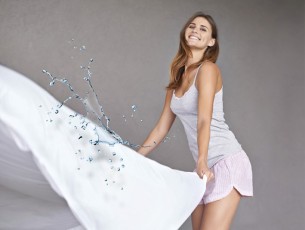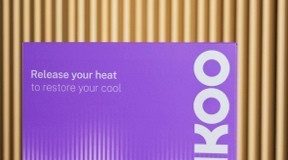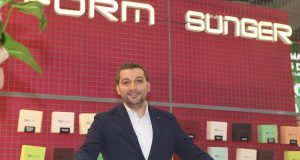* Humidity is found to be the key for climate comfort
What is “climate comfort” about? Climate comfort is a term often used in connection with the weather. But when looking at the human body – especially in sleeping environments – it is obvious that climate comfort plays a role in better sleep. However, “temperature” is not the only factor, as there are many subjective perceptions involved. Interesting: Humidity is widely agreed as big contributor to being uncomfortable. Outlast Technologies, market leader in phase change materials (PCM), has examined the topic and has generated some interesting results.
“We have run various tests to investigate the optimum sleeping climate,” says Martin Bentz, President of Outlast Technologies LLC, Golden/USA. “We are often asked to give evidence of the performance of our heat managing Outlast® products. Therefore we have looked at other test methods than climate chamber testing and have gained valuable knowledge demonstrating that the proactive nature of phase change materials positively influences sleeping comfort. Quickly, we found that ‘temperature’ is not the only indicator in creating a comfortable sleeping environment.”
It must be dry
A third party expert in Europe in the field around microclimate, Christoph Russ – owner of c.russ- NETCONSULT, Otterfing/Germany – says: “An important requirement for human comfort perception is the quality of the surrounding climate. But what is comfortable? What makes sense to one may not be the same for others – some will prefer warmer environments, and some will prefer cooler. But just with humidity, there is a wide consensus that being dry is more comfortable.”
He continues by saying, “scientific studies on the correlation between subjective climate perception and objective climate confirm these same points. The evaluation of human comfort perception with the measurement of absolute humidity clearly outranges the one with temperature. Simply speaking: When a human perspires, the body is attempting to cool itself. When it doesn’t perspire, typically the body is comfortable.”
Climate comfort = less perspiration
Excess humidity is critical in terms of discomfort. Therefore one important key to climate comfort is efficiently managing moisture. Christoph Russ confirms that the point of climate comfort is reached when the human – theoretically speaking – does just not perspire. “Then the climate is perfect.” In addition, Russ shows evidence with his testing method THG AreaView providing a live insight into the thermoregulation of a human body. “This method measures the individual’s limit between climate comfort and discomfort.”
In general, there are two ways of optimizing the climate comfort: the reactive deduction of humidity (humidity transport) and the proactive limitation of the production of humidity.
Convective trap
Less sweating, less humidity makes the difference in sleeping comfort. “Once the body finds ways to reduce overheating without perspiring it will take advantage of it in order to save energy,” confirms Christoph Russ. This is exactly where Outlast® materials make sense since they proactively manage moisture through the absorbance of heat.
The body reacts in a sensible way to temperature changes and normally starts sweating when it is getting too warm. Perspiration is a mechanism of the body to release excess heat and to regulate the body temperature. “The perspiration causes humidity beneath a duvet which, in spite of its intention to cool, actually increases the perception of temperature by approximately 2°C,” says Russ. “We call this a convective trap which is caused by a poor exchange of airflow. The individual then would need to move positions or remove the covers to create airflow – the consequence is a disturbed sleep.”
It is different with Outlast® technology: As Outlast® products absorb excess heat the body does not have to perspire to achieve cooling. The production of transpiration is already reduced, providing the additional benefit of better hygiene. This is a huge advantage – especially in bedding.
The evidence
The evidence: The independent test system THG SleepView (developed by Christoph Russ) makes it possible to visualize the benefits of Outlast® products related to heat and moisture, and to document the numerous advantages of the smart performance material. “We have conducted various tests with THG SleepView visually demonstrating that Outlast® materials can reduce moisture significantly during the phase where you fall asleep,” says Volker Schuster, Technical Director of Outlast Europe GmbH. “As the data sensors of this new measuring system are very small they can be built directly inside the microclimate to measure the air between the skin and duvet – this is where comfort plays a role,” says Volker Schuster. “We have found out that Outlast® materials support humans in their attempt to cool down the organism during the phase of falling asleep producing more than 10% less humidity. A very good start into the night leading to an efficient improvement of comfort.”
The Outlast® difference
Phase change materials help to actively balance temperature and to reduce humidity during sleep significantly. “We found out, that a duvet with an Outlast® PCM fiberfill can reduce absolute humidity by 48% compared to a traditional duvet,” adds Martin Bentz. “This is an impressive added value,” says Bentz, “which clearly demonstrates the proactive way our technology works. It is very important for us that our Outlast® products optimize the climate inside bedding proactively – contrary to other technologies which work through humidity transport.” This is exactly the Outlast® difference: This technology works continuously to manage heat and moisture while reducing sweat production right from the beginning, so less humidity is created inside the bed. The Outlast® difference then influences a person’s overall comfort that leads to a better night’s rest. Bentz adds: “Naturally, we lose up to one liter of sweat each night. Outlast® materials can reduce this amount by an average of 50%. You sleep drier and more comfortably.”
Outlast® technology
Outlast® technology was originally developed for NASA to protect astronauts from temperature fluctuations in space. Outlast® technology utilizes phase change materials (PCM) that absorb, store and release heat for optimal thermal comfort. Outlast® technology is comparable to ice in a drink; as it changes from solid to liquid, it absorbs heat and cools the drink, keeping that drink at the desired temperature for a longer period of time. Outlast® phase change materials work in the same way. The PCMs have the capacity to absorb, store and release excess heat. This gives any product containing Outlast® technology the ability to continually regulate the skin’s microclimate. As the skin gets hot, the heat is absorbed, and as it cools, that heat is released.
Outlast® technology is not wicking technology, which manages moisture by reacting to your sweat and pulling it away from the skin. Outlast® technology will proactively manage heat while controlling the production of moisture before it begins. That’s the Outlast® difference. The benefits of Outlast® products at a glance:
- Absorbs excess body heat § Manages moisture § Reduces overheating § Reduces chilling
- Reduces perspiration § Continuously adapts to thermal changes
Outlast presents the newest innovations at Heimtextil from 12 to 15 January, 2016, in Frankfurt; Hall 8.0, Stand D 74.
 SleepTech Magazine Mattress, Accessories, Machinery, Raw Materials
SleepTech Magazine Mattress, Accessories, Machinery, Raw Materials



